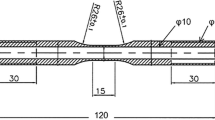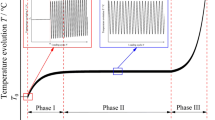Abstract
Low cycle fatigue (LCF) damage in titanium alloys has been traditionally assessed based on driving parameters such as stress, strain or hysteresis energy. These mechanical parameters sometimes fail to quantify the true contribution of stored damage energy which is the main cause of LCF damage in these alloys. Hence in the present investigation, thermal evolution captured on-line using lock-in infrared-thermography has been used to characterize low cycle fatigue damage of Ti–6Al–4V under a range of applied total strain amplitudes (0.8–1.8 %). The analysis of thermal signatures indicated that the contribution of thermo-elasticity decreased and inelasticity increased with an increase in strain amplitude due to significant change in damage micromechanism from quasi-cleavage to ductile mode. Increase in applied strain resulted into increased fatigue damage and consequently higher temperature increase. An inverse relationship similar to standard strain amplitude-fatigue life equation was established between temperature increase and fatigue life. The damage energy was evaluated using first law of thermodynamics i.e. law of energy conservation. Damage energy increased with an increase in applied strain amplitude. A relationship was also developed between damage energy and strain amplitude.











Similar content being viewed by others
References
Maldague, X.: Non-destructive Evaluation of Materials by Infrared Thermography. Wiley, London (2001)
Henneke, E.G., Reifsnider, K.L., Stinchcomb, W.W.: Thermography—an NDI method for damage detection. J. Met. 31, 11–15 (1979)
Huang, Y., Xu, J., Shih, C.H.: Application of infrared technique to research on tensile test. Mater. Eval. 12, 76–79 (1980)
Huang, Y., Li, S.X., Shih, C.H.: Advances in fracture research. In: Proceedings of the 6th International Conference on ‘Fracture’, p. 2325. Pergamon Press, New Delhi, India, Dec 1984
Sachdev, A.K., Hunter Jr, J.E.: Thermal effects during uniaxial straining of steels. Metall. Trans. A 13A, 1063–1067 (1982)
Yang, B., Liaw, P.K., Wang, H., Huang, J.Y., Kuo, R.C., Huang, J.G.: The application of nondestructive evaluation technologies. JOM-e (2003)
Wang, H., Jiang, L., Lee, Y.H., Chen, L.J., Liaw, P.K., Seeley, R.R., Klarstrom, D.L.: Infrared imaging during low-cycle fatigue of HR-120 alloy. Metall. Mater. Trans. A 33A, 1287–1291 (2002)
Yang, B., Liaw, P.K., Wang, H., Huang, J.Y., Kuo, R.C., Huang, J.G.: Thermographic investigation of the fatigue behavior of reactor pressure vessel steels. Mater. Sci. Eng. A A314, 131–139 (2001)
Kumar, J., Baby, S., Kumar, V.: Thermographic studies on IMI-834 titanium alloy during tensile loading. Mater. Sci. Eng. A 496(1–2), 303–307 (2008)
Liakat, M., Khonsari, M.M.: Rapid estimation of fatigue entropy and toughness in metals. Mater. Des. 62, 149–157 (2014)
Fan, J., Guo, X., Wu, C.: A new application of the infrared thermography for fatigue evaluation and damage assessment. Int. J. Fat. 44, 1–7 (2012)
Kordatos, E.Z., Aggelis, D.G., Matikas, T.E.: Monitoring mechanical damage in structural materials using complimentary NDE techniques based on thermography and acoustic emission. Composites B 43, 2676–2686 (2012)
Wang, X.G., Crupi, V., Guo, X.L., Zhao, Y.G.: Quantitative thermographic methodology for fatigue assessment and stress measurement. Int. J. Fat. 32, 1970–1976 (2010)
Wagner, D., Ranc, N., Bathias, C., Paris, P.C.: Fatigue crack initiation detection by an infrared thermography method. Fat. Fract. Eng. Mater. Struct. 33, 12–21 (2009)
Crupi, V.: An unifying approach to assess the structural strength. Int. J. Fat. 30, 1150–1159 (2008)
Choi, M., Kang, K., Park, J., Kim, W., Kim, K.: Quantitative determination of a subsurface defect of reference specimen by lock-in infrared thermography. NDT&E Int. 41, 119–124 (2008)
Roesner, H., Meyendorf, N., Karpen, W., Matlikas, T.E.: Development of enabling methodologies for detection and characterisation of early stages of damages in aerospace materials. In: Third Annual Report by the University of Dayton, DARPA NDE-MURI, AFOSR Grant No. F49620-96-1-0442, pp. 177-188 (1999)
Meyendorf, N., Roesner, H., Frouin, J., Maurer, J., Sathish, S.: Acousto-thermal microstructure characterization. In: Thompson, D.O. and Chimenti, D.E. (eds.) CP657, Review of Quantitative Nondestructive Evaluation, vol. 22, pp. 517–524. American Institute of Physics (2003)
Meyendorf, N.G.H., Roesner, H., Kramb, V., Sathish, S.: Thermo-acoustic fatigue characterization. Ultrasonics 40, 427–434 (2002)
Liaw, P.K., Wang, H., Jiang, L., Yang, B., Huang, J.Y., Guo, R.C., Huang, J.G.: Thermographic detection of fatigue damage of pressure vessel steels at 100 Hz and 20 Hz. Scr. Mater. 42(4), 389–395 (2000)
Naderi, M., Khonsari, M.M.: On the role of damage energy in the fatigue degradation characterization of a composite laminate. Composites B 45, 528–537 (2013)
Naderi, M., Kahirdeh, A., Khonsari, M.M.: Dissipated thermal energy and damage evolution of glass/epoxy using infrared thermography and acoustic emission. Composites B 43, 1613–1620 (2012)
Jacobsen, T.K., Sorensen, B.F., Brondsted, P.: Measurement of uniform and localized heat dissipation induced by cyclic loading. Exp. Mech. 38, 289–294 (1998)
Bledzki, A.K., Gassan, J., Kurek, K.: The accumulated dissipated energy of composites under cyclic–dynamic stress. Exp. Mech. 37, 324–327 (1997)
Reifsnider, K.L., Williams, R.S.: Determination of fatigue-related heat emission in composite materials. Exp. Mech. 14, 479–485 (1974)
Aglan, H.A., Gan, Y.X., Chu, F., Zhong, W.H.: Fatigue fracture resistance analysis of polymer composites based on the energy expanded on damage formation. J. Reinf. Plast. Compos. 22, 339–360 (2003)
Groot, S.R.D., Mazur, P.: Non-equilibrium Thermodynamics. Inter Science Publishers, New York (1962)
Halford, G.R.: The energy required for fatigue. J. Mater. 1, 3–18 (1966)
Kaleta, J., Blotny, R., Harig, H.: Energy stored in a specimen under fatigue limit loading conditions. J. Test. Eval. 19, 326–333 (1990)
Taylor, G.I., Quinney, H.: The latent energy remaining in a metal after cold working. Proc. R. Soc. A 143, 307–326 (1934)
Cho, C., Holmes, J.W., Barber, J.R.: Estimation of interfacial shear in ceramic composites from frictional heating measurements. J. Am. Ceram. Soc. 74, 2802–2808 (1991)
Holman, J.P.: Heat Transfer, 7th edn. McGraw-Hill, New York (1992)
Abolghasem, S., Basu, S., Shekhar, S., Cai, J., Shankar, M.R.: Mapping subgrain sizes resulting from severe simple shear deformation. Acta Mater. 60, 376–386 (2012)
Zhang, B., Shim, V.P.W.: Determination of inelastic heat fraction of OFHC copper through dynamic compression. Int. J. Impact Engg. 37, 50–68 (2010)
Maletta, C., Bruno, L., Corigliano, P., Crupi, V., Guglielmino, E.: Crack-tip thermal and mechanical hysteresis in shape memory alloys under fatigue loading. Mater. Sci. Eng. A 616, 281–287 (2014)
Knysh, P., Korkolis, Y.P.: Determination of the fraction of plastic work converted into heat in metals. Mech. Mater. 86, 71–80 (2015)
Venkataraman, B., Maneka, M., Vasudevan, M., Raj, B.: Thermography for online detection of incomplete penetration and penetration depth estimation. In: 12th A-PCNDT 2006-Asia Pacific Conference on NDT, Auckland, New Zealand, 5–10 Nov 2006
Acknowledgments
The authors gratefully acknowledge the Defence Research and Development Organization (DRDO) New Delhi, for funding the above research. Test support from Mr. K. Prasad and Mr. B. N. Kowmudi is also acknowledged.
Author information
Authors and Affiliations
Corresponding author
Additional information
This article is part of the Topical Collection on Thermography.
Rights and permissions
About this article
Cite this article
Kumar, J., Sundara Raman, S.G. & Kumar, V. Analysis and Modeling of Thermal Signatures for Fatigue Damage Characterization in Ti–6Al–4V Titanium Alloy. J Nondestruct Eval 35, 3 (2016). https://doi.org/10.1007/s10921-015-0317-5
Received:
Accepted:
Published:
DOI: https://doi.org/10.1007/s10921-015-0317-5




